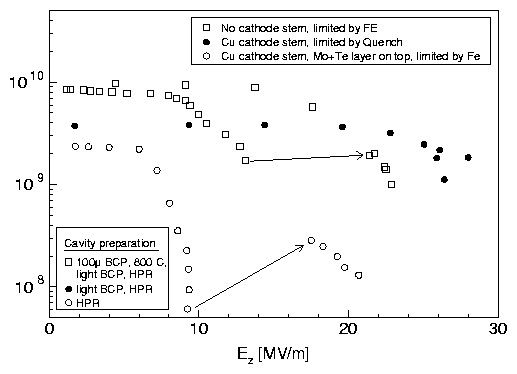|
The development of a superconducting RF photocathode gun (SRF gun) is under way.
SRF guns are the most advanced type of electron injectors, which
combine high brightness and large bunch charges of normal conducting RF guns
with the cw-mode and large average current of superconducting cavities.
Numerical calculations of beam parameters for this gun show excellent
results [1]. In the framework of the ELBE project we need
this gun for the following reasons: The minimal lenghts of the electron bunch, which can be obtained by this gun is smaller than 100 mm. This leads for an average electron current of 1 mA to a coherent undulator radiation in the order of 1 W with a wave lengths of 100 mm [2]. In this way for wavelengths l ³ 100 mm the SRF gun allows the generation of an intense, coherent infrared light without the optical resonator, used in the FEL. In order to obtain intense and monochromatic radiation in the X-ray region with an electron beam energy equal or less than 40 MeV (which is the maximal energy of the accelerator), in the framework of the ELBE project different methods are planned and under discussion. In all of these methods (channeling radiation, transition radiation, parametric X-rays, Compton back scattering) the radiation output increases with decreasing of transversal emittance. Furthermore, the output of the Compton backscattering increases with increasing bunch charge. The SRF gun provides for a given bunch charge essential lower transversal emittances than the conventional injector, which is installed in the first phase of the ELBE project [1]. In the ELBE project time-of-flight measurements of fast neutrons for experiments in astrophysics, nuclear physics and for transmutation experiments are planned. For these measurements a point like neutron source with intense neutron pulses and variable time structure is necessary. These neutron pulses can be obtained by the interaction of an electron bunch with a target, where the electron bunch has the same properties as one expects for the neutron pulse. So for these experiments an electron beam with large bunch charge, small emittance and variable time structure is necessary. The possibility to create such an electron beam is one of the advantages of the SRF gun [1]. The design of the SRF gun is described in [3]. The status of its five parts is the following:

Fig. 1 Results of the Vertical Cavity Tests obtained at a liquid Helium temperature of 2 K.
References
Zentralabteilung Strahlungsquelle ELBE 05/18/01 © D. Janssen |